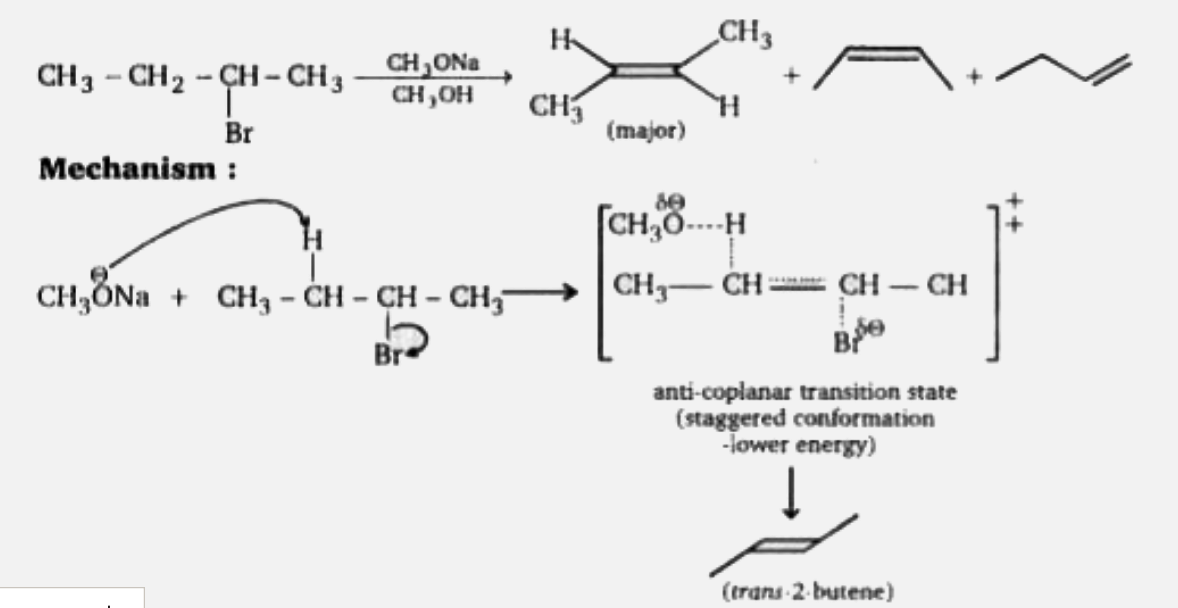Which of the following btea-keto carboxylic acid does not undergo decarboxylation on heating?Solution in Telugu



None of these
The correct Answer is:A
β-Keto acids undergo decarboxylation through the keto form via a cyclic T. S. which results in the formation of the enol form of the ketone product. The enol then changes to the more stable keto form. If decarboxylation of the given β-keto acid could follow this route, then:

If we draw the acid as shown in (I), it can be seen that the methylene group forms a bridge, which is perpendicular to the cyclohexane ring.

The enol produced would have a double bond in the 1, 2-position. Thus, C - 1 is sp2 - hybridised and therefore the bond leading to the methylene bridge (1, 3) would have to be coplanar with the groups joined to C - 2 in the enol, i.e., the bridge would have to flatten. This would require the normal valency angles (~109.5∘) to change to ~120∘. Even if a compromise situation occurred, i.e., all bond angles involved (∠s 1, 3, and 4) underwent change, the resulting strain would be very large, too large to be expected for it to occur. Hence, it is reasonable to argue that since decarboxylation does occur, it does so through a route requiring a much higher activation energy than that required for the usual route. Hence the difficulty of decarboxylation. (Bredt.s rule)
Related Playlists
- BOOK - MS CHOUHANCHAPTER - ALDEHYDES AND KETONESEXERCISE - LEVEL-220videos
ALDEHYDES AND KETONES
- BOOK - MS CHOUHANCHAPTER - ALCOHOL,ETHERS AND EPOXIDESEXERCISE - SUBJECTIVE PROBLEMS1videos
ALCOHOL,ETHERS AND EPOXIDES
- BOOK - MS CHOUHANCHAPTER - ALKYL HALIDES (ELIMINATION REACTION) EXERCISE - LEVEL-225videos
ALKYL HALIDES (ELIMINATION REACTION)
Similar Questions
Select the best choice for example (A to L) from the examples (a to n) given below. Write your choice in the box given.

 02:31View Solution
02:31View Solution
Maximum number of moles of Ac2O consumed by reactant (A) is :02:17View SolutionComprehension
E2 raction → Elimination bimolecular
In the general mechanism of the E2 reaction a strong base abstract a proton on a carbon atom adjacent to the one of the leaving group. As the abstracts a proton , a double bond forms and the leaving group leaves.

Identify the rate ofreaction of given compounds in E2 reaction:
 01:43View Solution
01:43View SolutionWhich of the following carboxylic acids undergoes decarboxylation easily ?
View SolutionWhich of the following Carboxylic acids donot undergo decarboxylation on heating?
02:02View SolutionWhich β-keto acid shown will not undergo decarboxylation?
02:11View SolutionWhich of the following carboxylic acids do not undergo decarboxylation simply on heating?
View SolutionWhich of the following β-keto carboxylic acid does not undergo decarboxylation on heating ?
05:33View SolutionWhich of the following carboxylic acids undergoes decarboxylation most easily on heating?
03:21View SolutionWhich of the following carboxylic acids undergoes decarboxylation on heating ?
03:21View SolutionWhich of the following carboxylic acids undergoes decarboxylation easil?
03:06View SolutionWhich of the following carboxylic acids undergoes decarboxylation easily
03:06View SolutionWhich of the following carboxylic acids undergoes decarboxylation easily
02:24View SolutionWhich of the following carboxylic acid undergoes decarboxylation easily:
01:20View SolutionWhich of the following carboxylic acid undergoes decarboxylation easily:
View SolutionWhich of the following are endothermic processes?
View Solution

